Commander James Bond is a Senior Operational Officer of the 'Double-O' ('00') Branch, an ultra-covert Black Ops unit within the British Secret Intelligence Service (MI6). As an agent of MI6, Bond holds code number "007". The 'double-O' prefix indicates his discretionary licence to kill in the performance of his duties.
Sean Connery was the first actor to perform the role on the big screen. He appeared in Dr. No (1962), From Russia with Love (1963), Goldfinger (1964), Thunderball (1965), You Only Live Twice (1967) and Diamonds Are Forever (1971). In 1983 he returned to the role for the last time in the unofficial James Bond film, Never Say Never Again. In addition he also provided his voice and likeness for 2005's video game adaptation of From Russia with Love.
Film biography
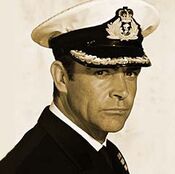
Bond was an expert seaman.
In the novels, James Bond is the son of a Scottish father, Andrew Bond of Glencoe, and a Swiss mother, Monique Delacroix, from the Canton de Vaud. He acquired a first-class command of the French and German languages during his early education, which he received entirely abroad. Both parents were tragically killed during a climbing accident in the French Alps when he was eleven.
After the death of his parents, Bond goes to live with his aunt, Miss Charmian Bond, where he completes his early education. Later, he briefly attends Eton College at "12 or thereabouts", but is removed after two halves because of girl trouble with a maid. After being sent down from Eton, Bond was sent to Fettes College in Scotland, his father's school.[1]
After leaving Fettes, earlier EON films note that Bond studied at Cambridge University. [2] [3] There, he achieved a first in Oriental languages. [4] In Fleming's novels, Bond alluded to briefly attending the University of Geneva (as did Fleming), before being taught to ski in Kitzbühel. [5]Following his graduation, Bond joined the Ministry of Defence and became a lieutenant in the Royal Naval Volunteer Reserves, rising though the ranks to commander. Bond applied to M for a position within the "Secret Service", part of the Civil Service, and rose to the rank of principal officer.
Dr. No (1962)
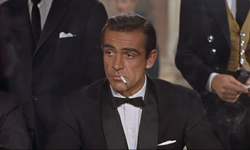
"Bond, James Bond" - Dr. No
Shortly before his next assignment, M, Bond's superior in MI6, gave him the choice of either selecting a new weapon on a mission to investigate the recent disappearance of MI.6 operative John Strangways or to return to standard intelligence duties. He was then given a choice of using a Walther PPK or a Smith & Wesson .38 Special 5-round hammerless revolver. Bond reluctantly decided to take the weapons on the mission and the Walther proved valuable in Jamaica, where Strangways had gone missing. (The Smith and Wesson is used against a swamp-jeep armed with a flamethrower rigged to look like a dragon, according to the novel.)
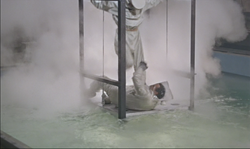
Bond fights Dr. No.
Although Bond's life was threatened on the mission several times by various murderous operatives, one of whom placed a tarantula in his bed, Bond found help in CIA agent Felix Leiter and native fisherman, Quarrel, who aided Bond in his investigation of Strangways' disappearance. After finally determining that a Dr. Julius No was responsible for Strangways' murder, Bond killed Dr. No in revenge and destroyed his island, Crab Key, before escaping in a boat with a beautiful Jamaican native named Honey Ryder. The two later encountered a Navy ship whose crew offered to tow their boat back to the Jamaican mainland. (Dr. No) In the novel, Bond sends a telegram to London, selecting the Walther, as the S&W is "not effective against dragons."
From Russia with Love (1963)
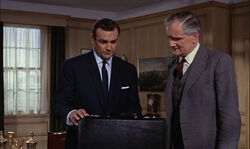
Bond later returned to London but, six months after he had left the city, he was sent on a mission to Istanbul in an attempt to obtain a Lektor decoder device from a stunning Russian cipher clerk named Tatiana Romanova, who had supposedly fallen in love with a photograph of him. Yet Tatiana had unknowingly been set up by the criminal organization SPECTRE, who wanted to avenge the murder of their operative, Dr. No. But despite several SPECTRE agents attempting to kill Bond, most notably Colonel Rosa Klebb (who used a poison-tipped shoe as a weapon before being killed by Tatiana) and devious assassin Red Grant (who attempted to garrote Bond on the train before he was killed), Bond was aided by Kerim Bey, who helped the British agent bring both the device and Romanova from Istanbul to Venice, via the Orient Express. (From Russia with Love) NR
Goldfinger (1964)
Subsequently, Bond was sent on a mission to Mexico, where he ensured that a revolutionary named Mr. Romales could no longer finance his revolutions. After the successful completion of his mission, Bond was attacked by an assailant, who he killed before taking a plane to Miami.
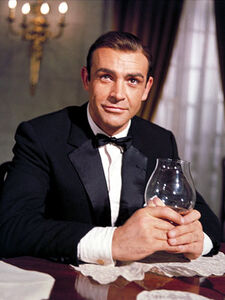
Bond in Goldfinger.
In Miami, Bond was instructed to observe Auric Goldfinger, who was staying at the same hotel. However, Bond became romantically involved with Goldfinger's girlfriend, Jill Masterson, who later died of skin suffocation as a result of being entirely covered in gold. Bond returned to London, where he was ordered to investigate Goldfinger's involvement in the possibly illegal transportation of gold, but he was warned that, if he treated the assignment as a personal vendetta, he would be replaced on the mission by 008. While investigating Goldfinger, Bond traveled from England to Geneva, Switzerland, where he met Jill Masterson's vengeful sister, Tilly Masterson, before she was killed by Goldfinger's henchman, Oddjob, with the modified bowler hat that he always wore. Bond determined that Goldfinger was indeed illegally smuggling gold but he was soon imprisoned by the criminal, who ordered his transportation to the United States, where Bond learned the specifics of the criminal's planned Operation Grand Slam (the robbery of Fort Knox). Bond ultimately prevented the criminal's destructive plan from becoming a reality and managed to kill both Oddjob by electrocuting him through his hat and, finally, Goldfinger. (Goldfinger) (In the novel, Goldfinger was one of the KGB's overseas treasurers.)
Thunderball (1965)
In France, James Bond fought and killed SPECTRE operative Colonel Jacques Bouvar, avenging the murder of two of Bond's former colleagues.
After encountering several SPECTRE agents at a health spa in the south of England, Bond was sent on a mission to stop SPECTRE operative Emilio Largo from using two stolen nuclear warheads against Britain or the United States. Bond succeeded and Largo was ultimately killed. (Thunderball)
You Only Live Twice (1967)
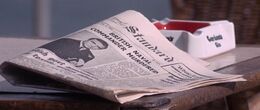
A newspaper reporting Bond's "death" in You Only Live Twice, dated July 9, 1966.
Shortly thereafter, Bond traveled to Japan, where he faked his own death. However, he was then sent by M to investigate the capture of a U.S. spacecraft and was later captured by SPECTRE head Ernst Stavro Blofeld. Bond helped destroy Blofeld's lair, but Blofeld himself escaped. (You Only Live Twice)
Diamonds Are Forever (1971)
Looking to avenge his wife, Tracy Bond, Bond raced around the globe looking for Blofeld until he found him during a plastic operation. After a fight, Bond apparently killed the SPECTRE head by melting him in hot mud.
Behind the scenes
1962-67
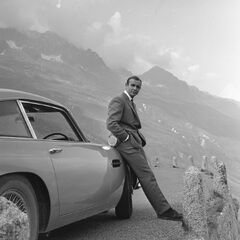
Sean Connery in a now iconic promotional still from Goldfinger.
Connery's breakthough came in the role of secret agent James Bond. He was reluctant to commit to a film series, but understood that if the films succeeded his career would greatly benefit.[6] He played the character in the first five Bond films: Dr. No (1962), From Russia with Love (1963), Goldfinger (1964), Thunderball (1965), and You Only Live Twice (1967) – then appeared again as Bond in Diamonds Are Forever (1971) and Never Say Never Again (1983). All seven films were commercially successful.
Sean Connery's selection as James Bond owed a lot to Dana Broccoli, wife of Cubby Broccoli, who is reputed to have been instrumental in persuading Cubby that Sean Connery was the right man.[7][8] James Bond's creator, Ian Fleming, originally doubted Connery's casting, saying, "He's not what I envisioned of James Bond looks" and "I'm looking for Commander Bond and not an overgrown stunt-man," adding that Connery (muscular, 6' 2", and a Scot) was unrefined. Fleming's girlfriend told him Connery had the requisite sexual charisma. Fleming changed his mind after the successful Dr. No première; he was so impressed, he created a half-Scottish, half-Swiss heritage for the literary James Bond in the later novels.
Connery's portrayal of Bond owes much to stylistic tutelage from director Terence Young, polishing the actor while using his physical grace and presence for the action. Robert Cotton wrote in one Connery biography that Lois Maxwell (the first Miss Moneypenny) noticed, "Terence took Sean under his wing. He took him to dinner, showed him how to walk, how to talk, even how to eat." Cotton wrote, "Some cast members remarked that Connery was simply doing a Terence Young impression, but Young and Connery knew they were on the right track."[9] The tutoring was successful; Connery received thousands of fan letters a week, and the actor became one of the great male sex symbols of film.[10] In preparation for the role, Connery admits to having read only three of Ian Fleming's Bond novels; Thunderball, EON's original choice for the first James Bond film, as well as Live and Let Die and From Russia, With Love.[11]
Although Bond had made him a star, Connery did not like the role, saying that he was "fed up to here with the whole Bond bit".[12] In addition to a growing weariness with the repetitive plots, lack of character development and the general public's demands on his privacy, an increasingly tense financial relationship had developed between Connery and the series producers.[13] Despite being contracted for one further film, in 1967 a frustrated Connery shocked the industry by announcing that he was hanging up his tuxedo and retiring from the role of 007.
Diamonds Are Forever (1971)
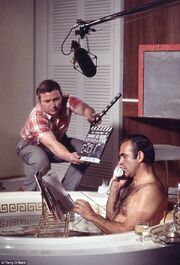
Sean Connery on the set of Diamonds are Forever.
In November 1969, prior to the release of the film adaptation of On Her Majesty's Secret Service, Connery's successor, actor George Lazenby announced that he no longer wished to play the role of James Bond.[14] Producers contemplated replacing him with John Gavin (though Batman star Adam West was also considered),[15] as well as Michael Gambon, who rejected the offer telling Broccoli that he was "in terrible shape."[16] United Artists' chief David Picker was unhappy with this decision and made it clear that Connery was to be enticed back to the role and that money was no object.
When approached about resuming the role of Bond, Connery demanded the extraordinary fee of £1.25 million (£23 million in 2013 pounds) and to entice the actor to play Bond one more time United Artists offered to back two films of his choice.[17] After both sides agreed to the deal, Connery used the fee to establish the Scottish International Education Trust, where Scottish artists could apply for funding without having to leave their country to pursue their careers. Since John Gavin was no longer in the running for the role, his contract was paid in full by United Artists.
Never Say Never Again (1983)
In 1983 Connery returned to the role of James Bond for Never Say Never Again, an unofficial film adaptation of the James Bond novel Thunderball, produced by Kevin McClory, one of the original writers of the Thunderball storyline with Ian Fleming and Jack Whittingham.
Marking his return to the role 12 years after Diamonds Are Forever, Connery had been tenuously attached to the floundering project since 1978 (under the working title James Bond of the Secret Service). When producer Jack Schwartzman became involved, he asked Connery to play Bond: Connery agreed, asking (and getting) a fee of $3 million, ($7 million in 2013 dollars) a percentage of the profits, as well as casting and script approval.[18] Subsequent to Connery reprising the role, the script has several references to Bond's advancing years – playing on Connery being 52 at the time of filming[18] – and academic Jeremy Black has pointed out that there are other aspects of age and disillusionment in the film, such as the Shrubland's porter referring to Bond's car ("they don't make them like that any more"), the new M having no use for the 00 section and Q with his reduced budgets.[19]
The film underwent one final change in title: after Connery had finished filming Diamonds Are Forever he had pledged that he would "never" play Bond again.[18] Connery's wife, Micheline, suggested the title Never Say Never Again, referring to her husband's vow[20] and the producers acknowledged her contribution by listing on the end credits "Title "Never Say Never Again" by: Micheline Connery".
Videogame appearances

Sean Connery's Bond as he appears in From Russia with Love.
In 2005, From Russia with Love was adapted by Electronic Arts into a video game, titled James Bond 007: From Russia with Love. It follows the storyline of the book and film, albeit adding in new scenes, making it more action-oriented.
Most of the cast from the film returned in likeness. Connery not only allowed his 1960s likeness as Bond to be used, but the actor, in his 70s, also recorded the character's dialogue, marking a return to the role 22 years after he last played Bond in Never Say Never Again.[21][22]
On-Screen Kills
See also
References
- ↑ (2004) You Only Live Twice. Kent, England: Penguin Books, pp.200-202. ISBN 978-0-1411-8754-9.
- ↑ (1967). You Only Live Twice [Motion Picture]. United Artists.
- ↑ (1977). The Spy Who Loved Me [Motion Picture]. United Artists.
- ↑ (1967). You Only Live Twice [Motion Picture]. United Artists.
- ↑ (2006) Octopussy and The Living Daylights. Kent, England: Penguin Books, p.35. ISBN 978-0-1411-8874-4.
- ↑ "Playboy Interview: Sean Connery", Playboy, 1965-11. Retrieved on 25 October 2011.
- ↑ Bray, Christopher. "Sean Connery: The Measure Of A Man", The Daily Telegraph, 3 March 2004.
- ↑ Dana Broccoli. Retrieved on 8 August 2012.
- ↑ Terence Young: James Bond's Creator?. hmss.com. Retrieved on 29 September 2007.
- ↑ "Playboy Interview: Sean Connery", Playboy, 1965-11. Retrieved on 25 October 2011.
- ↑ Sean Connery. (1971). Sean Connery 1971: The BBC Interview. BBC.
- ↑ "Playboy Interview: Sean Connery", Playboy, 1965-11. Retrieved on 25 October 2011.
- ↑ (2012). Everything or Nothing: The Untold Story of 007 (DVD). 20th Century Fox Home Entertainment.
- ↑ (2000). Inside On Her Majesty's Secret Service [DVD]. OHMSS Ultimate Edition DVD: MGM Home Entertainment Inc.
- ↑ Cite error: Invalid
<ref>tag; no text was provided for refs namedinside - ↑ David Walliams takes some acting tips from Michael Gambon, The Sunday Times
- ↑ Feeney Callan, Michael (2002). Sean Connery. Virgin Books, 217.
- ↑ 18.0 18.1 18.2 (2001) Kiss Kiss Bang! Bang!: the Unofficial James Bond Film Companion. Batsford Books. ISBN 978-0-7134-8182-2. Cite error: Invalid
<ref>tag; name "Barnes" defined multiple times with different content - ↑ Black, Jeremy (2005). The Politics of James Bond: from Fleming's Novel to the Big Screen. University of Nebraska Press. ISBN 978-0-8032-6240-9.
- ↑ Dick, Sandra. "Eighty big facts you must know about Big Tam", 25 August 2010, p. 20.
- ↑ Interview with David Carson. GameSpy (29 September 2005). Retrieved on 8 January 2011.
- ↑ Navarro, Alex (1 November 2005). From Russia With Love Review. GameSpot. Retrieved on 8 February 2011.
